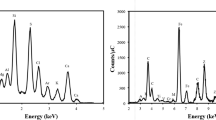Abstract
Mass-spectrometry research of secondary ion emission (MSSI) products is a direct method of analysis of the element and isotope content of conducting and nonconducting solid substances. Similar to other methods of mass-spectrometric analysis, MSSI also has some analytical characteristics that enable one to detect a simple reaction between a concentration of the analyzed element and the registered initial signal.
Similar content being viewed by others
References
Beske, H.E. Zangew, Positive secondary Phys. 1962, vol. 14, p. 30.
Fainberg, V.S. and Ramendik, G.I., On Possibility of Describing the Relative Yield of Secondary Ions by Means of Quasi-Equilibrium Model in Mass Spectrometry, Zh. Anal. Khim., 1991, vol. 46,issue 2, pp. 241–252.
Newbury, D.E. and Simons, D., Secondary Emission of Molecular Ions from Light Elements Targets, SIMS-IV Proc. 4th Conf. Berlin, 1984. p. 101.
Ramendik, G.I., Manzon, B.M., and Tyurin, D.A., Quasi-Equilibrium Model of Ion Formation in Investigations of Spark and Laser Mass Spectrometry, Zh. Anal. Khim, 1989, vol. 4, pp. 996–1007.
Bensen, K.M., Surkin, P., Gilbers, R., and Adams, F., Secondary Ion Mass Spectromety Depth Profiling and Simultaneous Inactivation, Spectrochim. Acta, 1984, vol. 38, no. 5, pp. 843–861.
Teylor, S.E., and McLennon, S.M., Molecular Rear-rangement Cluster Formation in the SIMS of Fluoride Salts, Chem. Geol. 1983, vol. 39, nos. 3 and 4, p. 273.
Ramkumar, K. L., Datta, B.P., and Kavimandan, V.D., On a Mechanism of Secondary Emission of Polyatomic Particles, F. Z. Anal. Chem, 1989, vol. 318, no. 1, p. 12.
Datta, B.P. and Yain, H.C., Focusing Errors of a Multiple-Focusing Time-of-Flight Mass Spectrometer with an Electrostatic Sector Fields, Int. J. Mass Spectrum Ion Proc., 1986, vol. 68, no. 3, p. 219.
Vos, L. and Van Cricken R., Cluster Induced Secondary Ion Emission, F. Z. Anal. chem., 1985, vol. 309, p. 32.
Sysoev, A.A. and Ivanov, V.P., High-vacuum Fast Operating Lock, Prib. Tekh. Eksp., 1995, vol. 55, no. 3, pp. 137–142.
Author information
Authors and Affiliations
Corresponding author
Additional information
Original Russian Text © A.M. Gashimov, K.Z. Nuriev, S.Manuchar, K.B. Gurbanov, Z.K. Nurubeili, 2008, published in Elektronnaya Obrabotka Materialov, 2008, No. 2, pp. 98–104.
About this article
Cite this article
Gashimov, A.M., Nuriev, K.Z., Manuchar, S. et al. Effective efficiency coefficients for standard-free analysis of solid substances by the method of mass spectrometry of secondary ions. Surf. Engin. Appl.Electrochem. 44, 159–164 (2008). https://doi.org/10.3103/S1068375508020142
Received:
Published:
Issue Date:
DOI: https://doi.org/10.3103/S1068375508020142




